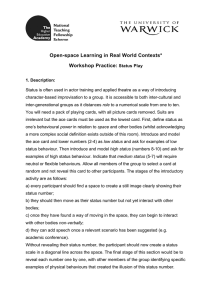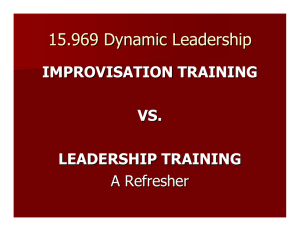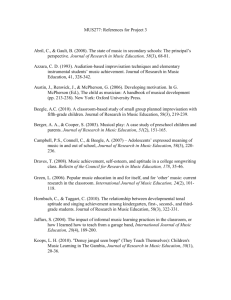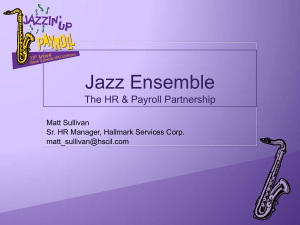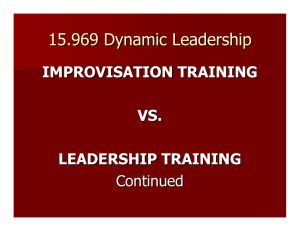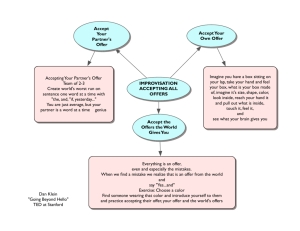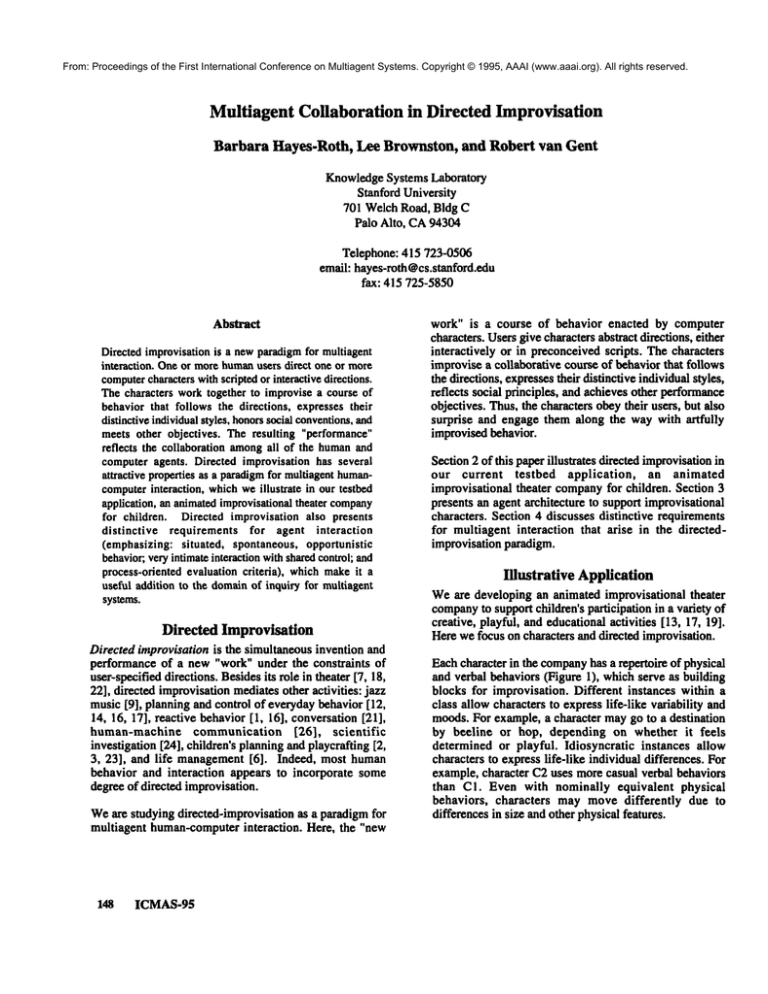
From: Proceedings of the First International Conference on Multiagent Systems. Copyright © 1995, AAAI (www.aaai.org). All rights reserved.
Multiagent Collaboration in Directed Improvisation
BarbaraHayes-Roth,Lee Brownston,and Robertvan Gent
KnowledgeSystems Laboratory
Stanford University
701 Welch Road, Bldg C
Palo Alto, CA94304
Telephone: 415 723-0506
email: hayes-roth @cs.stanford.edu
fax: 415 725-5850
Abstract
Directed improvisationis a newparadigmfor multiagent
interaction. Oneor morehumanusers direct one or more
computercharacterswithscripted or interactivedirections.
The characters work together to improvise a course of
behavior that follows the directions, expresses their
distinctive individualstyles, honorssocial conventions,and
meets other objectives. The resulting "performance"
reflects the collaboration amongall of the humanand
computeragents. Directed improvisation has several
attractive properties as a paradigmfor multiagenthumancomputerinteraction, whichweillustrate in our testbed
application, an animatedimprovisationaltheater company
for children. Directed improvisation also presents
distinctive requirements for agent interaction
(emphasizing: situated, spontaneous, opportunistic
behavior;veryintimateinteractionwithsharedcontrol; and
process-oriented evaluation criteria), whichmakeit
useful addition to the domainof inquiry for multiagent
systems.
Directed Improvisation
Directed improvisation is the simultaneous invention and
performance of a new "work" under the constraints of
user-specifieddirections. Besidesits role in theater [7, 18,
22], directed improvisation mediates other activities: jazz
music[9], planning and control of everyday behavior [12,
14, 16, 17], reactive behavior [1, 16], conversation [21],
human-machine communication [26], scientific
investigation [24], children’s planningand playcrafting [2,
3, 23], and life management[6]. Indeed, most human
behavior and interaction appears to incorporate some
degree of directed improvisation.
Weare studying directed-improvisation as a paradigmfor
multiagent human-computerinteraction. Here, the "new
148
ICMAS-95
work" is a course of behavior enacted by computer
characters. Usersgive characters abstract directions, either
interactively or in preconceived scripts. The characters
improvise a collaborative course of behavior that follows
the directions, expressestheir distinctive individual styles,
reflects social principles, and achieves other performance
objectives. Thus, the characters obeytheir users, but also
surprise and engage them along the way with artfully
improvised behavior.
Section2 of this paper illustrates directed improvisationin
our current testbed application,
an animated
improvisational theater companyfor children. Section 3
presents an agent architecture to support improvisational
characters. Section 4 discusses distinctive requirements
for multiagent interaction that arise in the directedimprovisation paradigm.
Illustrative Appfication
Weare developing an animated improvisational theater
companyto support children’s participation in a variety of
creative, playful, and educational activities [13, 17, 19].
Here we focus on characters and directed improvisation.
Eachcharacter in the companyhas a repertoire of physical
and verbal behaviors (Figure 1), which serve as building
blocks for improvisation. Different instances within a
class allow characters to express life-like variability and
moods. For example, a character maygo to a destination
by beeline or hop, depending on whether it feels
determined or playful. Idiosyncratic instances allow
characters to express life-like individual differences. For
example, character C2 uses more casual verbal behaviors
than C I. Even with nominally equivalent physical
behaviors, characters may move differently due to
differences in size and other physical features.
From: Proceedings of the First International Conference on Multiagent Systems. Copyright © 1995, AAAI (www.aaai.org). All rights reserved.
Say (~
Vo.
Greet
Go to [x]
--~
Bound
CI: Hi, Hello
C2: Howdy,Yo, Say hey
J~e
Wobble r~..~
Beeline
Hop
.~,
Farewell
C1: By, By bye, Good-bye,So long
C2: Adios, I’m outa here, Later gator
Play-alone
Invite [to do x]
Dance "T~
C1: Doyou want to, Will you, Please
C2: Let’s, Howabout, Wanna
Run around’~
Agree
Play-with [x]
~’~ C1: OK, Sure, Yes,Allright, Fine
C2: Whynot, Fine by me, Okle-dolde
~
Play follow.the-leader
Refuse
C1: Nothanks, Sorry, I don’t want to
C2: Uh uh, Nope, No way
Fight-with [x]
Figure 1. Excerpts from behavioral repertoires of two characters, C1 and C2.
Our illustrations are based on two characters that we
adapted from the "woggles" system of J. Bates of
Carnegie-Mellon University (including the RALsystem
of Production Systems Technologies). Unlike the CMU
woggles, our characters have multiple gaits, speak lines,
follow directions, and improvise. Each character has
about 10 classes of physical behaviors and 20 classes of
verbal behaviors, each with 1-5 instances. The characters’
verbal behaviors and personalities were conceived and
recorded by Aaron and Nora Hayes-Roth, who were 13
and 10 years old at the time. Weplan to develop new
human-like animated characters that will have similar
behaviors, as well as new behaviors. To create stories,
children direct the characters to adopt moods and to
perform sequences of behaviors. The characters improvise
within the constraints of the directions.
Wehave
conceived several interaction modes[13, 18], but present
only twohere for illustration.
In animated-puppets mode, children direct characters
interactively by makingchoices from situated behavior
menus.For example, in Figure 2, the large character feels
cheerful and energetic. It considers going somewhere,
playing alone, or inviting its partner to play. The small
character feels OK,but tired. It considersgoing to the rest
area, playing alone, or speaking. One child directs the
large character to invite its partner to play. The character
improvises an appropriate course of behavior (e.g.,
approach the small character, greet it, and say "Do you
want to play follow the leader?"). Its executed behaviors
changethe shared situation and, as a result, the behaviors
both characters subsequently consider. The children work
side by side, directing their characters’ moods and
behavior to create a shared story, just as they wouldwith
physical puppets. The characters also collaborate on the
playcrafting, improvising within the constraints of the
children’s directions. Wehave implemented animated
puppets, with graphical user interfaces similar to the
schematic ones in Figure 2, for the two characters
described above [19].
I
feel:
Cheerfu"l’~
Energetic
~~I
~~r~~]
Animation stem
RightnowI can:
Do
Go._~ to x
Play-alone
Vocalize
Invite’to-Play
feel:?
OK
Tired
RightnowI can:
Play-alone
J
e~P
Vocalize
Figure 2. Snapshot from situated behavior menus for a
two-character play.
Hayes.Roth
149
From:InProceedings
of the Firstmode,
International
Conference
Multiagent Systems. Copyright
1995, AAAI
(www.aaai.org).
All rights reserved.
animated-actors
children
direct oncharacters
receives©control
plans
from its cognitive
controller
prospectively by giving them synchronized behavior
scripts. For example, in Figure 3, the characters begin by
playing independently (e.g., dancing, hopping on the
pedestal). C2 determines when "awhile" has passed and
suggests a game(e.g., hide and seek, follow the leader).
CI agrees and the two characters play the gametogether.
The characters also may improvise script-independent
behaviors (e.g., exchangegreetings in a chance encounter
while playing alone). Wehave implementeda few simple
behaviorscripts for brief conversations(e.g., greeting and
reply; invitations and acceptances to play) and for games
(e.g., follow the le~_der). Weare developinga repertoire
such scripts as a form of reusable knowledge to be
incorporated in different characters.
CharacterC1
Character C2
M ood.’Ch,er~ul~
M ooeL’Cheer/,l~
Play-alone
for awhile
and
enacts those plans with appropriate physical behaviors,
sending their outputs to effectors on its animated
embodiment
and to its user interface.
Cognitive
~
Cognitive
Play-Mone
for awhile
~
Sayinvite-to.playto A1
Figure 4. Frameworkfor a Two-Character
Production.
Sayagree-lo-lday
to A2
Play.with A2
~..~
Play-with AI
~.~
The End
The End
Figure3. Synchronized
Behavior
Script.
The animated theater company illustrates
multiagent
human-computer collaboration
in the directedimprovisation paradigm. Children collaborate to create the
narrative structures of stories and direct the behavior of
characters within the structure. Characters collaborate
with children to implement the directions and with one
another to determine the details of their interactions.
Characters’ improvisations may reflect moods and
personalities, social conventions, relationships amdrecent
interactions, and improvisational expertise. The balance
of creative work shifts amongchildren and characters,
dependingon the specificity of the children’s directions.
AnArchitecturefor ImprovisationalActors
Each animated character embodies an intelligent agent
(Figure 4), whose two-level architecture comprises
cognitive controller and a physical controller [11, 17]. An
agent’s cognitive controller receives perceptual inputs
from its physical controller, constructs an evolving model
of its situation and its interactions with other characters,
plans its physical and verbal behaviors, and sends control
plans to its physical controller. An agent’s physical
controller interprets and filters inputs from its user
interface and from sensors on its animated embodiment
and sends those perceptions to its cognitive controller. It
150
ICMAS-95
A dynamic control model [10, 12, 15, 16] underlies an
agent’s cognitive and physical controllers, each of which
iterates this cycle: (a) its agenda manager triggers
behaviors for the current situation; (b) its scheduler
chooses the best triggered behavior based on the current
control plan; and (c) its executor performs the chosen
behavior. The cycle has three key features, as illustrated
in Figure 5. First, the agent continually notices possible
behaviors. For example, the agent might notice that it’s
able to play any of several games, go somewhere, say
something, etc. Second, the agent describes its intended
behavior in abstract control plans that permit alternative
realizations. For example,the control plan "go to x" can
be realized by "bound to pedestal," "hop to pedestal,"
"hop to rest area," etc. Third, the agent generates and
modifies its control plans at run time. For example, the
agent refines its plan to "go to x" by planning to "hop to
pedestal." At each point in time, the agent performs
possible behaviorsthat matchits current control plans.
Our architecture is a natural frameworkfor directed
improvisation. The agenda manager generates situated
behaviors--the raw materials out of which a character
creates meaningful behavior patterns. Dynamiccontrol
plans can represent children’s scripted and interactive
directions. Dynamiccontrol planning enables characters
to improvisethe details of directions and to augmentthem
with undirected behaviors on the fly. Characters can use
knowledge of the distinctive properties of behavior
instances within a class to choose amongthem. For
example, given the direction "Goto x," a character might
chooseany of five gaits.
From: Proceedings of the First International Conference on Multiagent Systems. Copyright © 1995, AAAI (www.aaai.org). All rights reserved.
I: Playalone
S2: Gotox&Say y
~
PhysicalController
......
_¼_f_
,......,.,...
,.,,e,, 4JJ’
IN!I
SituatedBehaviorMenu
Figure $. DynamicControl Plans Integrate Users’
Scripted and Interactive Directions with Characters’
Improvisational Decisions (in/ta//cs),
If it previously had adopted a "silly" mood, it would
choosea silly gait: hop, wobble,or jiggle. If the direction
were more specific, "Go quickly to x," the character
would choose a fast gait: bound or beeline. These
examples illustrate
a very simple form of directed
improvisation, solo choice amongalternative behaviors.
Table 1. Formsof Directed Improvisation.
Solo
Collaborative
Improvisation
Improvisation
One-Steplt~ ~rovisation
Choose amongalternative
Respondto a partner’s
logically equivalent
behaviors
behaviors
Direction: Goto pedestal
Improvise: Hopto pedestal3
Sequential I~
Construct a coherent path to
a dramatic moment
Partner: Greeting
Improvise: Return greeting
Direction: Play alone, Rest
Improvise: Play alone, Get
tired, Rest
Partner: Goingtoward
7rovisation
Recognize and coordinate
with a partner’s behavior
sequence
To support multi-agent collaborative improvisation, we
are elaborating our agent architecture so that agents can
monitor, interpret, and predict their partners’ behavior
with the same mechanismsthey use to represent, plan,
monitor, and control their ownbehavior. In Figure 6, the
large character enters the set first and makesa plan to
look for something (1). The small character enters (2),
observesits partner standing still, and infers nothing about
its moodor plans (3). The small character plans to "start
something" by playing alone for awhile and then hiding
(4). Meanwhile,the large character observes its partner
enter and start playing alone and infers that it is acting
"shy" (5). The large character plans an appropriate
interaction: approach,greet, and invite the shy partner to
play (6). Now, the two characters have unknowingly
constructed conflicting plans. One of them must change
its plan and perhaps its modelof its partner. However,as
discussed below, it doesn’t matter which character
changes, as long as their observable interactions are
plausible. Thus, if the large character succeedsin inviting
the small character to play, the small character must
abandonits plan and agree to play. If the small character
notices the large character approachingand rushes over to
tell it to hide, the large character must abandonits plan
and its model of its partner and go hide. The extended
architecture enables characters to generate and adapt their
models of one another and their plans for their own
behavioras their interaction unfolds.
Partner’#ControlP~
S. ObserveP (Infer)
En~r ~y41one (shy) ~="l
My~ntrol P/m
1. Leekfor semething
6. InteractwithshyP
Go-reP GreetInvite-I
.........................
Partner’sCom~l
Pla~
3. Ob~rve
P (Infer)
Stand~tt (???)
D
MyComrolPl~
2. Enter4. Start somethina
I
~a~!_o_ne
male
1
........._’_
.............................
pedestal
Improvise: Go toward
pedestal,
Meetat pedestal
Patterned Im ~rovisation
iInstantiate an
Recognizeand participate
improvisational schema
in a partner’s schema
Direction: Dance:
Improvise: Iterate( Hop,
twirl)
Table 1 characterizes six forms of directed improvisation
that vary in: (a) the involvementof partners; and Co)
complexityof the recognized situation and the improvised
course of behavior. Weare working on developing these
more sophisticated forms of improvisational expertise in
our agents.
Partner: Play hide and
seek?
Improvise: I count to 10,
etc.
Figure 6. Simple Illustration of Collaborative
Improvisation
Issues in MultiagentInteraction
Directed improvisation is a new interaction paradigmfor
multiagent systems. Although it shares important
requirements and approaches with previously-studied
Hayes-Roth
151
From: Proceedings of the First International Conference on Multiagent Systems. Copyright © 1995, AAAI (www.aaai.org). All rights reserved.
multiagent paradigms(e.g., cooperative problemsolving,
distributed work, discretionary cooperation [8]), it
presents three distinctive requirements that make it a
useful addition to the domainof inquiry. Wehave taken
these requirements from the writings and teachings of
improvisation experts [7, 20, 22, 24] and view them as
designobjectives in our efforts to elaborate and instantiate
the proposedagent architecture.
firmly situated in the dynamiccontext, spontaneousin its
short-term etiology, and opportunistic in its thematic
relationships to other aspects of the performance.
Ensemblebehavior builds incrementally out of individual
agents’ actions and reactions. Achievementof the "goal"
is not the specific productof a deliberate, provablycorrect
process, but an emergent and uncertain epiphenomenonof
the agents’ reai-time interactions.
Directed improvisation demandsbehavior that is situated,
spontaneous, and opportunistic in the service of abstract
and weakly-constrained goals.
Directed improvisation demandsintimate collaboration
and shared control among agents engaged in closely
intertwined and interdependent behaviors.
Most multi-agent paradigms assume that agents’
individual and collective activities are predominantlyand
specifically goal-directed. In cooperative problemsolving,
the team’s goal is to solve a shared problem.In distributed
work, the team’s goal is to get all of the work done as
efficiently and effectively as possible. In discretionary
cooperation, individual agents have their owngoals and
cooperate to the degree that doing so enhances
achievement of their own goals or at least does not
compromisethem. Techniques for these paradigms focus
on goal-directed reasoning in support of individual and
group planning. Unplannedbehavior occurs only when it
is necessary to compensate for plan failure or when it
happensto advanceplanned efforts to achieve established
goals.
Most multi-agent paradigms assume that agents have
limited interest in working together and limited
interactions during the actual performance of their
collective activities. In cooperative problemsolving and
distributed work, agents work together because they are
committedto solving a shared problemor to completing a
shared job. The prevailing interaction modelis to divideand-conquerthe joint task so that individual agents can
workmore or less independently. Multi-agent planning is
used to allocate and coordinate tasks amongagents, with
run-time communication used primarily to exchange
selected results of individual activities and, in somecases,
to reallocate responsibilities. In discretionary cooperation,
individual agents have their owngoals and may or may
not be willing to work together at all, dependingon what
it costs them. Competition for resources or conflict
amonggoals may impede cooperation or even motivate
agents to thwart one another’s efforts, raising issues of
trust and deception. Communications focus mainly on
determining agents’ willingness to cooperate. In all of
these paradigms, research concentrates on the key
question of how agents should decide in advance whois
able and willing to do what. Techniques have been
developed for: problem decomposition, communicationof
assumptions, beliefs, decisions, and commitments;
negotiation and persuasion; conflict resolution and
consensus building; organization of effective chains of
command;and establishing mutually beneficial social
laws.
The directed-improvisation paradigm also assumes that
agents have goals, but they are less well defined and less
constraining
than in other paradigms. Agents
collaborating in a production share a general goal to
produce a successful joint performance that meets the
constraints of the users’ directions. Althoughdirections
can vary in specificity, effective application of the
paradigmtypically involves relatively abstract directions
that only weakly constrain the performance and give
characters plenty of freedom to improvise. The working
assumption is that producing the directed behaviors is
easy; the art lies in the improvisation. The literature on
improvisation reflects this assumptionin its prescription
of two underlying cognitive heuristics for the improviser:
(a) welcomepossibilities (Just let the wordsflow. Do not
fear mistakes. Turn off the censor. Lookfor relationships.
Do not plan too far ahead.); and (b) pursue promising
possibilities (Makethe natural response. Relate present
actions to past actions. Keepthe action on stage. Listen
and respond to your partner. Take it to the extreme.
Accept (don’t block) offers). In contrast to the forwardlooking, goal-directed reasoning and planning of agents in
traditional paradigms, effective improvisers engage in
backward-looking efforts to reincorporate incidental
themesand behavioral qualities that they or their partners
happen to have generated previously.
Thus, the
improviser at work is sometimes described as "a man
walking backwards, trying to make sense of where he’s
been" [24]. In sum, the individual agent’s behavior is
152
ICMAS-95
By contrast, the directed improvisation paradigmassumes
that agents are 100%committedto collaboration on their
joint performanceand that they will work together every
step of the way. Their prospective workis so intertwined
(and unpredictable) that agents do not even think
dividing it up aheadof time. Instead, effective improvisers
rely on one another to do what is necessaryto generate the
work jointly and interactively in real time. The work is
intrinsically collaborative: noneof the participating agents
can progress without interacting with its partners.
Individual agents mayintroduce plot devices or instantiate
improvisational routines. Theymaybuild small individual
plans of activity in particular situations. However,
all such
structures,
routines, and plans are tentative and
dispensable under the fundamental rule of collaborative
From: Proceedings of the First International Conference on Multiagent Systems. Copyright © 1995, AAAI (www.aaai.org). All rights reserved.
improvisation:Accept all offers. An"offer" is any explicit
or implicit assertion. Nomatter howan individual agent
feels about a partner’s offer, no matter where the
individual had been planning to go in the performance
prior to the offer, no matter howthe partner’s offer
redirects the individual’s behavior, there can be only one
response: "Yes." An effective
improviser always
embracesa partner’s offers and tries to advancethem with
constructive, collaborative behavior. Since all of the
participants are allowed to makeoffers and since not all
offers are detected or understood by partners, each
improviser must be willing to both lead and follow, with
no preconception of when, how often, or how long. The
dynamism and mutual adaptation of good improvisers
reflects this underlying willingness to share control.
Unlike control regimes based on organization,
negotiation, turn-taking, or other explicit arrangements,
shared control is an implicit arrangement in which the
participants readily and immediatelyadopt and contribute
to one another’s assertions, goals, strategies, and tactics so
that they can moveforward together.
Directed improvisation succeeds whenit produces a joint
performancethat follows the script and directions in an
engaging manner.
anew. By implication, instead of behavior that is correct,
rational, and reliable, effective improvisers produce
behavior that appears appropriate in context, varies in
different performances, and, in the best case, is
endearingly idiosyncratic. The individual qualities that
agents bring to a production are not costly distractions,
but powerful sources of texture and depth in their
contributions to the joint performance.In contrast to the
all-business mentality of the ideal agent in traditional
multi-agent paradigms, effective improvisers bring
believablecharacters to life.
Concluding Remarks
In this paper, we have tried to illustrate the promiseof
directed improvisation as a paradigm for multiagent
systems. First, it provides a structured frameworkfor
multiagent, human-computer
collaboration [8]. Second, it
explicitly allows run-time flexibility in the mannerin
whichobjectives can be achieved[I, l I, 16, 17]. Third, it
offers a familiar, life-like, and potentially delightful
interactive experience [4, 5]. Finally, because of its
distinctive requirements for agent interaction, directed
improvisation represents a useful addition to the domain
of inquiry for multiagent systems.
Most multi-agent paradigms are "product-oriented"--they
evaluate the objective consequencesof agents’ behavior
against high objective standards: achievement of agents’
individual and collective goals, optimal use of resources,
and acceptability of side effects. These criteria for
evaluating group performance imply related criteria for
evaluating individual performance. To succeed as a
memberof the group, an agent must: reason correctly in
performing its own tasks, reliably execute its planned
physical behaviors, model its partners’ knowledge and
behavior correctly, make rational decisions about
commitments to cooperative
behavior, keep its
commitmentsor at least inform its partners of changes,
etc. Features of agents’ behavior that do not affect the
product are not valued, maybe distracting, and, in the
worst case, maycarry unacceptable costs.
By contrast, the directed improvisation paradigm is
"process-oriented"--the joint course of behavior enacted
by computer characters is their product. Other than
meeting the constraints of users’ directions (which is
usually assumed to be easy), there is no "correct" or
"incorrect" performance. There is no concern with
resources and unexpected side effects are simply folded
into the performance. In general, there can be many
alternative, equally "successful" performancesof a given
script--that is, performancesthat follow the directions in
an engaging manner. In fact, in domains like our
computer theater, children (and adults) may find
especially charmingto observe or participate in repeated
performancesof a favorite story or one they have created
themselves just to see howthe characters will improvise
Hayes-Roth
153
From: Proceedings of the First International Conference on Multiagent Systems. Copyright © 1995, AAAI (www.aaai.org). All rights reserved.
References
I. Agre, P.E., and Chapman, D. What are plans for?
Robotics and AutonomousSystems, 6, 17-34, 1990.
2. Applebee, A.N. The User’s Concept of Story. Chicago:
University of ChicagoPress, 1978.
3. Baker-Sennett, J. Matusov, E., and Rogoff, B.
Sociocultural processes of creative planning in children’s
playcrafting. In P. Light and G. Butterworth (eds.),
Context and Cognition: Waysof 1.earning and Knowing.
NewYork: Harvester Wheatsbeaf, 1992.
4. Bates, J. The role of emotion in believable agents.
Communicationsof the ACM,1994, 37, 122-125.
5. Bates, J., Hayes-Roth,B., Laurel, B., and Nilsson, N.
Working notes of the AAAISymposiumon believable
agents, Menlo Park, CA: AAAI,1994.
6. Bateson, M.C. Composinga Life. NY: The Atlantic
MonthlyPress, 1989.
7. Belt, L., and Stockley, R. Improvisation through
Theater Sports. Seattle: Thespis Productions, 1991.
8. Charib-draa, B., Mandiau,R., and Millot, P. Distributed
artificial intelligence: Anannotated bibliography. SigArt
Bulletin, 3,1992, 20-37.
9. Dean, R. Creative Improvisation: Jazz, Contemporary
Music and Beyond. Philadelphia: Open University Press,
1989.
10. Hayes-Roth,B. A blackboardarchitecture for control.
Artificial Intelligence, 1985, 26, 251-321.
11. Hayes-Roth, B. An architecture
for adaptive
intelligent systems.Artificial Intelligence, in press, 1994.
12. Hayes-Roth, B. Architectural foundations for realtime performance in intelligent
agents. Real-Time
Systems, 2, 99-125, 1990.
13. Hayes-Roth, B. Directed improvisation: A new
paradigm for computer games. Proc. of the Computer
GameDevelopers’ Conference, Santa Clara, 1995.
i 4. Hayes-Roth,B. Opportunistic control of action. IEEE
Trans. on Systems, Man,and Cybernetics, 12, 1575-1587
1993.
15. Hayes-Roth,B., and Collinot, A. A satisficing cycle
for real-time reasoning in intelligent agents. Expert
Systemswith Applications, 7, 1993.
154
ICMAS-95
16. Hayes-Roth, B., and Hayes-Roth, F. A cognitive
modelof planning. Cognitive Science, 1979, 3, 275-310.
17. Hayes-Roth,B., Pfleger, K., Lalanda,P., Morignot,P.,
and Balabanovic, M. A domain-specific
software
architecture for adaptive intelligent systems. IEEETrans.
on Software Engineering, in press, 1994.
18. Hayes-Roth,B. Sincoff, E., Brownston,L., Huard, R.,
and Lent, B. Directed improvisation. Stanford University:
KnowledgeSystems Laboratory Technical Report KSL94-61, 1994.
19. Hayes-Roth,B. Sincoff, E., Brownston,L., Huard, R.,
and Lent, B. Directed improvisation with animated
puppets. Proc. of CHI ’95 Conference on ComputerHumanInteraction; Denver, 1995.
20. Johnstone, K. IMPRO:Improvisation in the Theatre.
NewYork: Penguin Books, 1987.
21. Moore, J. Invited presentation at the National
Conferenceon Artificial Intelligence, 1994.
22. Nachmanovitch,S. Free Play: Improvisation in life
and art. Los Angeles: JeremyP. Tarcher, Inc. 1990.
23. Rogoff, B., Gauvain, M., and Gardner, W. The
development of children’s skills in adjusting plans to
circumstances. In S. Friedman, E. Scholnick, and R.
Cocking (eds.), Blueprints for Thinking: The role
planning in psychological development. NewYork:
CambridgeUniversity Press, 1987, 303-20.
24. Ryan, P. Personal communication, Stanford
University, Course HS173 Improvisation - Discovering
Spontaneity, 1994.
25. Stefik, M. Planning and meta-planning (MOLGEN:
part 2). Artificial Intelligence, 16, 1981,141-169.
26. Suchman, L. A. Plans and Situated Actions: The
Problem of Machine/HumanCommunication. Cambridge,
England: CambridgeUniversity Press, 1987.

